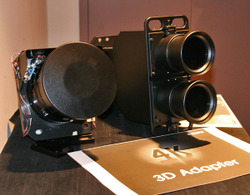Sony: 3D 4K in 09
At a press event yesterday evening in Sony Pictures' Culver City, California, headquarters, Sony took the chance not only to tout its latest advances in digital cinema, but also to show how those advances could make 3D commonplace in movie theaters - and soon. And that, of course, means it'll be more commonplace in homes, too.
The company started with demos of its latest 4K digital cinema projector, the $95,000 SRX-R220. A 4K projector produces a picture at least 4,000 pixels across; in the case of the SRX-R220, the exact resolution is 4,096 x 2,160 pixels. That's roughly four times the resolution produced by one of today's 1080p home projectors, and Sony's digital cinema execs kept hammering the point home that 4K's superior quality will get people out of the home theaters and into the commercial theaters. (It's worth noting that 4K has already made inroads into the home market, too.)
From what I saw and heard, the demos of 4K video transferred from film - clips of Lawrence of Arabia and Hancock - didn't much impress the assembled journalists. What did impress everyone, though, was the 3D demo we saw next. Sony used a 4K projector to blast out two 2K images, and handed out polarized glasses to the crowd. What ensued was probably the best 3D demo I have ever seen.
The visual veracity depended on the material, of course, but in some scenes the on-screen objects displayed realistic depth and dimension, rather than the "cardboard cutout" look that objects often take on in 3D. The demo included many amazing computer animation scenes, most notably one portraying a marauding pack of T-Rexes taking on a herd of brontosauruses. Video of a football game shot in 3D looked really good, too.
 The device that will make 4K 3D possible is Sony's new dual-lens adapter, which goes on sale in March of next year. The demo we saw used a prototype that is "about 20 times larger than the actual adapter will be," according to a Sony exec, but the company promises the performance with the actual adapter will be comparable. The downside is that screen brightness with the adapter drops to 4.5 footlamberts. That's only one-fourth as bright as a decent home projector (and considerably less bright than the SMPTE spec of 16 footlamberts for a film projector with no film in the gate), but in Sony's totally darkened theater, I didn't hear any complaints that the picture looked too dim.
The device that will make 4K 3D possible is Sony's new dual-lens adapter, which goes on sale in March of next year. The demo we saw used a prototype that is "about 20 times larger than the actual adapter will be," according to a Sony exec, but the company promises the performance with the actual adapter will be comparable. The downside is that screen brightness with the adapter drops to 4.5 footlamberts. That's only one-fourth as bright as a decent home projector (and considerably less bright than the SMPTE spec of 16 footlamberts for a film projector with no film in the gate), but in Sony's totally darkened theater, I didn't hear any complaints that the picture looked too dim.
Of course, it's great that compelling 3D presentations may become commonplace in digital cinemas. What's more exciting for Sound & Vision readers is that if there's a lot of 3D content produced for theaters, it's sure to make its way into homes. After all, TVs capable of 3D have been available for a year now.-Brent Butterworth
- Log in or register to post comments





























































